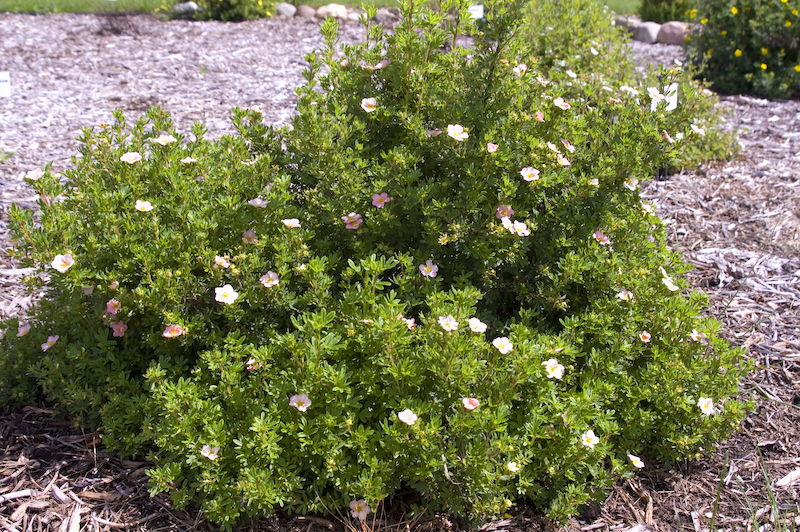Potentilla is a lovely, cold-hardy, flowering perennial. Potentilla fruticosa is native to North America, and once acclimated, it is relatively low maintenance and will provide consistent blooms from spring through the first frost. The semi-double flowers are generally white, pink, or yellow. Delicate-looking petals encircle protruding yellow stamens. Medium-sized plants have an upright, mounded growth habit and reach about 1 to 2 feet tall and wide. Many gardeners love Potentilla because it is charming, reliable, and drought tolerant.

Planting Potentilla
Location is perhaps the most important thing to consider when planting Potentilla. Most varieties grow as perennials in USDA zones 2 through 8. When selecting an area in your yard for this plant, be mindful of the amount of sunlight the site receives. Potentilla needs full to partial sunlight. Low light levels may prevent the plant from setting blooms or encourage it to become straggly.

Watering Potentilla
Newly planted Potentillas need consistent watering. The soil should be kept damp to help establish a robust root system. From the second year on, Potentilla plants need water twice a week or whenever the top several inches of soil are dry. Seasoned or established plants are drought tolerant, although watering the plant during a dry spell will ensure they continue to thrive. Water during the morning when possible, so the plant can take on the afternoon heat better.
Fertilizing Potentilla
Native plants typically do not require fertilization, but giving the plant some extra nutrition will keep Potentilla looking amazing. When it comes to fertilizing Potentilla, gardeners have several options. However, one method is usually enough to support healthy growth. Rich soil will encourage new foliage and flowers. Create the right soil conditions by amending the soil with organic compost or manure during planting or spreading organic mulch around the base of the plant each year. Another option is to apply a balanced fertilizer.

Pruning Potentilla
Trimming back the stems of the Potentilla in the spring will allow you to shape the plant and rejuvenate growth. Pruning will cause the plant to develop a more full and bushy look as it pushes out new leaves and branches in other areas in response to trimming. Prune the plant again during the summer to maintain a more desirable shape, promote new growth, and keep the flowers blooming.
Caring For Potentilla in Pots
Potentilla plants are low maintenance, whether grown in the ground or pots. The reliable blooms can brighten up window boxes, patio planters, or any place needing some color. The ideal pot or container will have drainage because soggy conditions can be damaging. While it is necessary for the soil to dry out between watering, container-grown plants will need water more often. Plants in containers will need water daily or possibly every other day, depending on rainfall.
Winter Care for Potentilla
A bit of maintenance in the fall will help Potentilla plants easily handle winter weather. The woody stems can normally handle snow, but be prepared to cover the plant if it is near a building or structure, and snow sliding off the roof could land on the plant. Foraging animals may nibble on the bark, so wrap the plants during the winter if you have previously had problems with animal damage. Remove any wrap or cover when the weather starts to warm in the spring.
Common Care Questions About Potentilla
Is Potentilla Edible?
Dried leaves of Potentilla fruticosa are used to steep tea, particularly in the Himalayas! Several parts of potentilla anserina variety are edible. The leaves and stems are often added to a salad, and roots can be eaten either raw or cooked.
Is Potentilla Invasive?
Shrubby Cinquefoil (Potentilla fruticosa) is not considered an invasive species, though they'll steadily fill in any gaps at a moderate rate, if left to do so.
Is Potentilla An Annual Or Perennial?
Potentilla fruticosa are deciduous shrubs, losing their leaves during the cold winter months. There are low maintenance perennial and ground cover varieties of potentilla, also.
Why Are The Leaves On Potentilla Turning Yellow, Brown, and/or Black?
Yellowing leaves on potentilla are often signs there is an iron deficit in the soil, or that the plant may be under- or over-watered. Iron levels can be corrected by introducing a supplement such as chelated iron powder or blood meal. Browned leaves are usually indicative of insufficient hydration, applying mulch around the busy can help hold moisture in the soil to avoid this.
What Is The Growth Rate Of Potentilla?
Potentilla have a moderate to fast rate of growth, and can vary from 1 to 2 (or more) feet annually.
Is Potentilla Drought Tolerant?
Once potentilla are established they are drought tolerant, but through the first season, soil should be kept consistently and evenly moist to help promote healthy, deep reaching root systems. During extreme, prolonged heat, watering once or twice a week may be necessary.
Have a question about Potentilla? Fill out the form below and we will try and get back to your question as soon as possible. We may even feature your question in this article to help other gardeners!
 |
Author Alison Cotsonas - Published 07-12-2022 |
